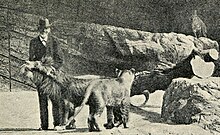Carl Hagenbeck

Carl Hagenbeck (10. juni 1844 – 14. april 1913) regnes ofte som "den moderne Zoo's fader", da han introducerede "naturlige" indhegninger der genskabte dyrenes oprindelige habitater, uden tremmer for.[1] Han stammede fra Tyskland og solgte vilde dyr til mange zoologiske haver i Europa, så vel som til P.T. Barnums cirkus. Hagenbeck grundlagde Tierpark Hagenbeck, Tysklands mest succesrige private zoologiske have, der blev flyttet til sin nuværende adresse i Hamburgs Stellingenkvarter i 1907. Han rolle som foregangsmand i forsøgene med at vise dyr sammen med mennesker – i det der er blevet kaldt "menneskelige zoologiske haver" – er mindre kendt.
Referencer
- ^ "Hagenbeck Tierpark und Tropen-Aquarium" (engelsk). Zoo and Aquarium Visitor. Hentet 2008-07-22.
The founder and his idea Carl Hagenbeck built what no other dared dream of. In 1907, the Hamburg man opened the first barless zoo in the world. As early as the end of the nineteenth century, this son of a fishmonger had the idea of showing animals no longer caged up but in open viewing enclosures. In his zoo of the future, nothing more than unseen ditches were to separate wild animals from members of the public. Carl Hagenbeck patented this idea in 1896. Nine years later his dream was to come true in Hamburg-Stellingen. The revolutionary open viewing enclosures and panoramas were in fact ridiculed in professional circles but took the public's breath away. Hagenbeck's zoo is considered to have prepared the way for today's wildlife adventure parks.
